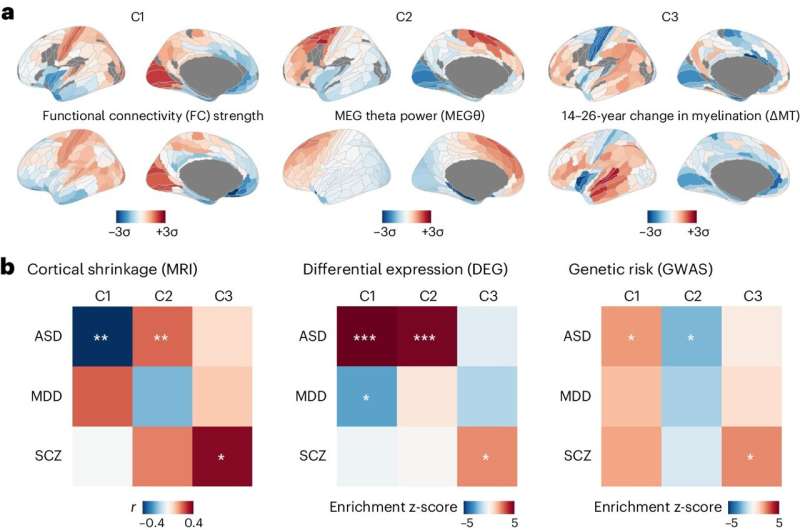
Three patterns of gene expression each align with distinct features of known neurobiology: C1 aligns with functional connectivity strength, C2 with brain oscillations in the theta-band range, and C3 with adolescent brain plasticity. Below, we show heatmaps (corrected for multiple comparisons) of the convergent associations between the three patterns C1-C3 and three mental health conditions – autism spectrum disorder (ASD), major depressive disorder (MDD), and schizophrenia (SCZ) – across three previously unrelated methods of analysis (cortical shrinkage from neuroimaging, differential gene expression from postmortem RNA sequencing, and genetic risk from genome-wide association studies), revealing autism to be consistently associated with C1 and C2, and schizophrenia to be consistently associated with C3. Credit:Nature Neuroscience(2024). DOI: 10.1038/s41593-024-01624-4.
The organization of the human brain develops over time, following the coordinated expression of thousands of genes. Linking the development of healthy brain organization to genes involved in mental health conditions such as autism and schizophrenia could help to reveal the biological causes of these disorders.
Researchers at University of Cambridge and other institutes worldwide recently carried out a study that linked gene expression in healthy brains to the imaging, transcriptomics and genetics of autism spectrum disorder and schizophrenia. Their paper, published in Nature Neuroscience, unveiled three distinct spatial patterns of cortical gene expression each with specific associations to autism and schizophrenia.
“Prior work had shown that all human brains have the same primary spatial pattern of gene expression (C1) reflecting the hierarchy of connections between neurons,” Richard Dear, co-author of the paper, told Medical Xpress. “Our hypothesis was that there is probably more than one pattern organizing how the twenty-thousand human genes are expressed across our brains.”
The primary objective of the recent study by Dear and his colleagues was to uncover new spatial patterns of gene expression. They hoped that these new patterns would shed light on so-called “transcriptional programs,” the biological mechanisms through which the human brain develops both in health and disease.
“The key challenge for this study was the limited data available,” Dear said. “The Allen Human Brain Atlas remains the only gene expression dataset with high spatial resolution across the brain, and it was collected from only six healthy donors. We therefore had to find a way to identify patterns in these limited data that we were confident represent general transcriptional programs shared across all human brains.”
As part of their study, the researchers ran various computational analyses to validate their results, including a permutation test for robustness and validation in three distinct types of independent data. They also searched for associations between the new transcriptional programs and previously published data related to brain organization, development, gene expression, and genetic variation associated with brain function in both health and disease.
“What was most striking was how each new analysis that we performed converged on the same consistent story,” Dear explained. “The second pattern of gene expression (C2) relates to cognitive metabolism and autism, while the third pattern (C3) relates to brain plasticity in adolescence and schizophrenia. Critically, both patterns were identified and validated entirely in brains from neurotypical donors.”
Dear and his collaborators are the first to link neurotypical brain gene expression to autism and schizophrenia across three common types of prior results (i.e., case-control neuroimaging, differential gene expression, and genome-wide association studies). Their results suggest that data collected using these distinct techniques, which previously appeared to be unrelated, can in fact be traced back to the same transcriptional programs that guide the development of healthy human brains.
“The next step for us will be to dive deeper into the biology of the three patterns to understand them at a more mechanistic level, leveraging recently published single-nucleus RNA sequencing data,” Dear added. “For example, we hope to discover the key genes or transcription factors guiding the expression of the C1–C3 patterns early in development across different cell types. We also hope that these three patterns and the optimized analysis code we developed will be a resource for other scientists seeking to understand the genetic underpinnings of the brain’s spatial organization.”
More information:
Richard Dear et al, Cortical gene expression architecture links healthy neurodevelopment to the imaging, transcriptomics and genetics of autism and schizophrenia, Nature Neuroscience (2024). DOI: 10.1038/s41593-024-01624-4
© 2024 Science X Network
Citation:
Study links organization of neurotypical brains to genes involved in autism and schizophrenia (2024, May 11)
retrieved 11 May 2024
from https://medicalxpress.com/news/2024-05-links-neurotypical-brains-genes-involved.html
This document is subject to copyright. Apart from any fair dealing for the purpose of private study or research, no
part may be reproduced without the written permission. The content is provided for information purposes only.
>>> Read full article>>>
Copyright for syndicated content belongs to the linked Source : Medical Xpress – https://medicalxpress.com/news/2024-05-links-neurotypical-brains-genes-involved.html
